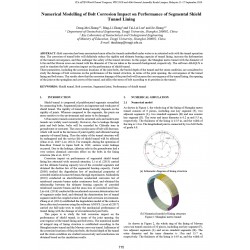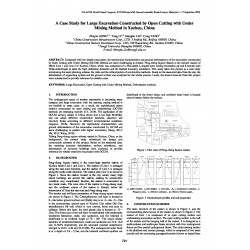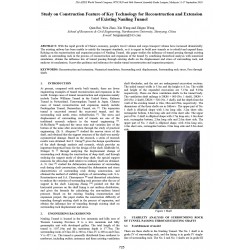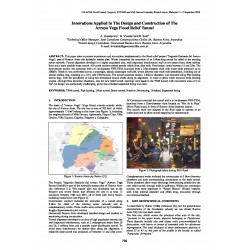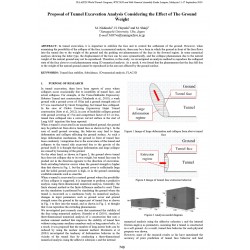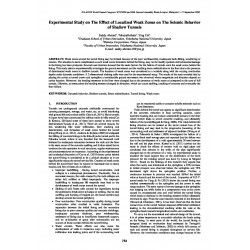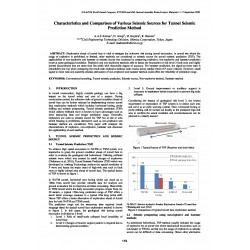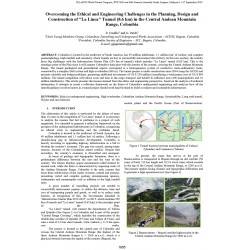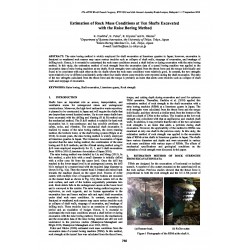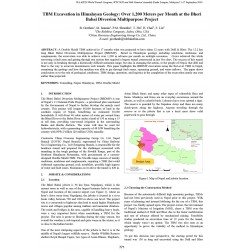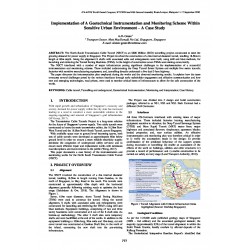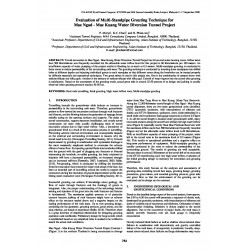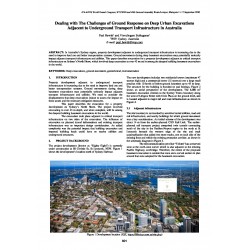No document
Search & filter
Search for a publication
Search & filter
World Tunnelling Congress
WTCThere are 1984 documents.
-
Numerical Modelling of Bolt Corrosion Impact on Performance of Segmental Shield Tunnel Lining
Abstract: Bolt corrosion has been encountered more often for tunnels embedded under water or in saturated soils with the tunnel operation time. The corrosion of tunnel bolts will definitely reduce the rigidity and ultimate bearing capacity of tunnel lining, increase the deformation of the tunnel convergence, and thus endanger the safety of the tunnel structure. In this paper, the Shanghai metro tunnel...
0,00 € -
A Case Study for Large Excavation Constructed by Open Cutting with Under Mining Method in Xuzhou, China
Abstract: Compared with the simple excavation, the mechanical characteristics and ground deformations of the excavation constructed by Open Cutting with Under Mining (OCUM) Method are more challenging to predict. Peng-cheng Square Station is the transfer station of Metro Line 1 and Line 2 in Xuzhou, China, which was composed of a 23m-depth L-shaped open cutting foundation pit and 8 tunnels with...
0,00 € -
Study on Construction Feature of Key Technology for Reconstruction and Extension of Existing Nanling Tunnel
Abstract: With the rapid growth of China's economy, people's travel volume and cargo transport volume have increased dramatically. The existing railway has been unable to satisfy the transport standards, so it is urgent to build new tunnels or to rebuild and expand them. Relying on the reconstruction and expansion project of Nanling Tunnel, this paper studies the influence of tunnel passing through...
0,00 € -
Brenner Base Tunnel, Italian Side, Lot Mules 2-3: Monitoring, Surveys, Investigations and Checks during Construction
Abstract: Lot Mules 2-3 is the main segment of BBT (Brenner Base Tunnel) on Italian Side. The paper illustrates the activities forecasted in Detailed Design (performed by the Designer Joint Venture: Pro Iter – leader, Pöyry Schweiz, Pini Swiss Engineers and Pasquali Rausa Engineering) and carried out during construction, to compare the design assumptions to the actual behavior of both the rock mass and...
0,00 € -
269 Innovations Applied in the Design and Construction of the Arroyo Vega Flood Relief Tunne
Abstract: This paper aims to present experiences and innovations implemented in the flood relief project “Segundo Emisario del Arroyo Vega”, part of Buenos Aires city hydraulic master plan. Works comprised the execution of an 8.4km-long tunnel for relief of the existing sewer network. Tunnel alignment develops in a highly populated area, with important interferences such as two metro lines, three railway...
0,00 € -
Proposal of Tunnel Excavation Analysis Considering the Effect of the Ground Weight
Abstract: In tunnel excavation, it is important to stabilize the face and to control the settlement of the ground. However, when examining the possibility of the collapse of the face, in numerical analysis, there may be a form in which the ground in front of the face flows into the tunnel due to the weight of the ground and the pushing out phenomenon of the face in the forward region. In some numerical...
0,00 € -
Experimental Study on the Effect of Localized Weak Zones on the Seismic Behavior of Shallow Tunnels
Abstract: Weak zones around the tunnel lining may be formed because of the poor workmanship, inadequate back-filling, weathering or erosion. The situation is more complicated as such weak zones formation behind the lining, may not be readily spotted until substantial damage to the lining has been produced. Several case histories showed that the main factors for the failure of tunnels were the weak zones...
0,00 € -
Characteristics and Comparison of Various Seismic Sources for Tunnel Seismic Prediction Method
Abstract: Exploration ahead of tunnel face is vital to mitigate the unknown risk during tunnel excavation. In tunnel site where the usage of explosive is prohibited or limited, other methods are considered as seismic source for tunnel seismic prediction (TSP). The applicability of non-explosive and hammer as seismic source was analyzed by comparing explosive, non-explosive and hammer prediction result at...
0,00 € -
Overcoming the Ethical and Engineering Challenges in the Planning, Design and Construction of "La Línea" Tunnel (8.6...
Abstract: Colombia is located in the northwest of South America, has 49 million inhabitants, 1.1 million km² of surface; and complex geomorphology, high rainfall, and seismicity where tunnels are key to successfully interconnect the territory. In this new century, the country faces big challenges with the Infrastructure Master Plan (250 km of tunnels) which includes "La Línea” tunnel (8,65 km). This is...
0,00 € -
Tunneling through 48 Fault Zones and High Water Pressures on Turkey’s Gerede Water Transmission Tunnel
Abstract: The December 2018 breakthrough of a 5.5 m diameter hybrid-type Single Shield/EPB TBM at the Gerede Water Transmission Tunnel in Central Turkey was a feat of modern construction. The 9 km leg was the final section of the 31.6 km long water supply line bored through what is widely considered to be Turkey’s most challenging geology. The project was originally started with the contractor selecting...
0,00 € -
Estimation of Rock Mass Conditions at Ten Shafts Excavated with the Raise Boring Method
Abstract: The raise boring method is widely employed for shaft excavation at limestone quarries in Japan; however, excavation in fractured or weathered rock masses may cause serious troubles such as collapse of shaft walls, stoppage of excavation, and breakage of drilling tools. Hence, it is essential to understand the rock mass conditions around a shaft before or during excavation with the raise boring...
0,00 € -
TBM Excavation in Himalayan Geology: Over 1,200 Meters per Month at the Bheri Babai Diversion Multipurpose Project
Abstract: A Double Shield TBM achieved in 17 months what was projected to have taken 12 years with Drill & Blast: The 12.2 km long Bheri Babai Diversion Multipurpose Project (BBDMP). Bored in Himalayan geology including sandstone, mudstone, and conglomerate, the excavation was able to achieve over 1,200 m advance per month on multiple occasions. Crews achieved this while traversing a fault zone and...
0,00 € -
Implementation of a Geotechnical Instrumentation and Monitoring Scheme within Sensitive Urban Environment - A Case Study
Abstract: The North–South Transmission Cable Tunnel (NSCT) is an $800 Million (SGD) tunnelling project constructed to meet the growing demand for power supply in Singapore. The Project involved the construction of a 6m internal diameter tunnel, totalling 18.5km in length at 60m depth. Along the alignment 8 shafts with associated adits and enlargements were built, using drill and blast methods, for...
0,00 € -
Evaluation of Multi-Standpipe Grouting Technique for Mae Ngad - Mae Kuang Water Diversion Tunnel Project
Abstract: Tunnel excavation in Mae Ngad - Mae Kuang Water Diversion Tunnel Project has hit several water-bearing zones. Inflow more than 500 liters/minute was frequently recorded but the allowable water inflow level for this project is 60 liters/minute per 100 meters. An insufficient capacity of water pumping of the project results in flooding by as much as 0.5 meters. Multi-standpipe grouting is...
0,00 € -
Adding to the Busiest Railway Station in Australia - Design and Construction Planning to Insert Sydney Metro’s...
Abstract: Development of viable construction methodologies and sequences was an integral part of the Reference Design for the new Sydney Metro platforms at Central Station, beneath existing Platforms 13 to 15. This paper outlines the approaches proposed to protect existing assets; maintain rail operations; and maintain passenger movements; whilst facilitating construction of the new metro station....
0,00 € -
Dealing with the Challenges of Ground Response on Deep Urban Excavations Adjacent to Underground Transport...
Abstract: In Australia’s Sydney region, property development adjacent to underground transport infrastructure is increasing due to the need to improve land use and better transportation systems. Ground movements during deep basement excavations may potentially seriously impact adjacent transport infrastructure and utilities. This paper describes excavation for a property development adjacent to critical...
0,00 €

